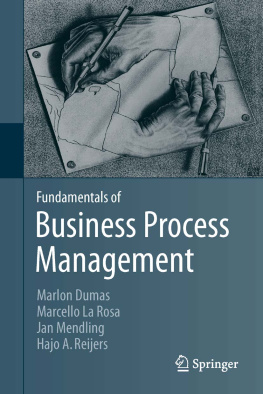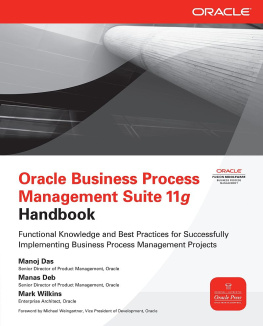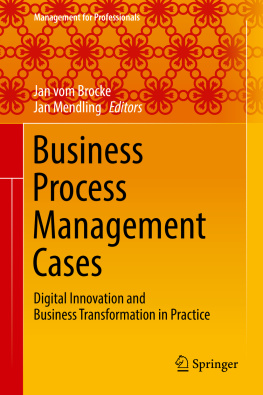Marlon Dumas Marcello La Rosa Jan Mendling - Fundamentals of Business Process Management
Here you can read online Marlon Dumas Marcello La Rosa Jan Mendling - Fundamentals of Business Process Management full text of the book (entire story) in english for free. Download pdf and epub, get meaning, cover and reviews about this ebook. year: 0, publisher: Springer Berlin Heidelberg, Berlin, Heidelberg, genre: Computer. Description of the work, (preface) as well as reviews are available. Best literature library LitArk.com created for fans of good reading and offers a wide selection of genres:
Romance novel
Science fiction
Adventure
Detective
Science
History
Home and family
Prose
Art
Politics
Computer
Non-fiction
Religion
Business
Children
Humor
Choose a favorite category and find really read worthwhile books. Enjoy immersion in the world of imagination, feel the emotions of the characters or learn something new for yourself, make an fascinating discovery.
- Book:Fundamentals of Business Process Management
- Author:
- Publisher:Springer Berlin Heidelberg, Berlin, Heidelberg
- Genre:
- Year:0
- Rating:5 / 5
- Favourites:Add to favourites
- Your mark:
- 100
- 1
- 2
- 3
- 4
- 5
Fundamentals of Business Process Management: summary, description and annotation
We offer to read an annotation, description, summary or preface (depends on what the author of the book "Fundamentals of Business Process Management" wrote himself). If you haven't found the necessary information about the book — write in the comments, we will try to find it.
Fundamentals of Business Process Management — read online for free the complete book (whole text) full work
Below is the text of the book, divided by pages. System saving the place of the last page read, allows you to conveniently read the book "Fundamentals of Business Process Management" online for free, without having to search again every time where you left off. Put a bookmark, and you can go to the page where you finished reading at any time.
Font size:
Interval:
Bookmark:
- Order-to-cash : This is a type of process performed by a vendor, which starts when a customer submits an order to purchase a product or a service and ends when the product or service in question has been delivered to the customer and the customer has made the corresponding payment. An order-to-cash process encompasses activities related to purchase order verification, shipment (in the case of physical products), delivery, invoicing, payment receipt and acknowledgment.
- Quote-to-order : This type of process typically precedes an order-to-cash process. It starts from the point when a supplier receives a Request for Quote (RFQ) from a customer and ends when the customer in question places a purchase order based on the received quote. The order-to-cash process takes the relay from that point on. The combination of a quote-to-order and the corresponding order-to-cash process is called a quote-to-cash process.
- Procure-to-pay : This type of process starts when someone in an organization determines that a given product or service needs to be purchased. It ends when the product or service has been delivered and paid for. A procure-to-pay process includes activities such as obtaining quotes, approving the purchase, selecting a supplier, issuing a purchase order, receiving the goods (or consuming the service), checking and paying the invoice. A procure-to-pay process can be seen as the dual of quote-to-cash process in the context of business-to-business interactions. For every procure-to-pay process there is a corresponding quote-to-cash process on the suppliers side.
- Issue-to-resolution . This type of process starts when a customer raises a problem or issue, such as a complaint related to a defect in a product or an issue encountered when consuming a service. The process continues until the customer, the supplier, or preferably both of them, agree that the issue has been resolved. A variant of this process can be found in insurance companies that have to deal with insurance claims. This variant is often called claim-to-resolution .
- Application-to-approval. This type of process starts when someone applies for a benefit or privilege and ends when the benefit or privilege in question is either granted or denied. This type of process is common in government agencies, for example when a citizen applies for a building permit or when a businessman applies for a permit to open a business (e.g. a restaurant). Another process that falls into this category is the admissions process in a university, which starts when a student applies for admission into a degree. Yet another example is the process for approval of vacation or special leave requests in a company.
Font size:
Interval:
Bookmark:
Similar books «Fundamentals of Business Process Management»
Look at similar books to Fundamentals of Business Process Management. We have selected literature similar in name and meaning in the hope of providing readers with more options to find new, interesting, not yet read works.
Discussion, reviews of the book Fundamentals of Business Process Management and just readers' own opinions. Leave your comments, write what you think about the work, its meaning or the main characters. Specify what exactly you liked and what you didn't like, and why you think so.












